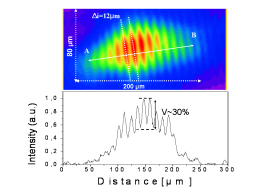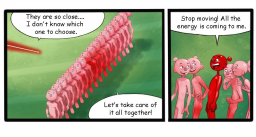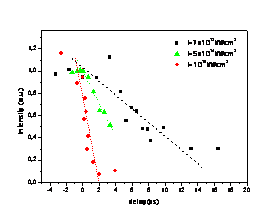Laboratoire Francis Perrin
Scientific Goal


The Francis Perrin Laboratory carries on research in the field of physical chemistry. A large part of the projects is dedicated to the interaction between light (UV-visible-IR) and molecular systems and are pursued along four interconnected objectives:
- Describe the fundamental processes involved when light interacts with a molecular system, e.g. processes relevant to femtochemistry or induced by collective effects (biomolecules, clusters)
- Unravel the mechanisms underlying natural phenomena, such as protein folding or carcinogenic mutations, by using light
- Contribute to the development of nanoscience and nanotechnology
- Elaborate new applications in the field of environment, alternate energy resources, health…
#552 - Last update : 06/20 2013
More ...
Brief introduction to ion acceleration : Undoubtedly, the acceleration of charged particles has been one of the most active research fields in the physics of laser-matter interaction all along the last ten years. In itself, laser driven ion acceleration was already a well known phenomenon although essentially circumscribed to the thermal expansion of the coronal plasma typical of nano and sub-nanosecond low intensities laser pulses interaction regimes.
Imaging XUV interferometer : Internal conversion frequency imaging interferometer at 32nm
Interferometry allows for getting electronic density information in 2D. For this purpose, we have set up, in collaboration with Attophysic group and LCF-IO, an innovative instrument based on the mutual coherence properties of two High order Harmonic (HHG) from gas jet in the XUV domain. Interferometry, in this wavelength domain, exhibits strong difficulties, due to handling of the beams.
Members of MHDE group : Permanent researchers :
Thomas Blenski
+33 1 69 08 96 64
thomas.blenski@cea.fr
Theory: physic of dense plasmas
Michel Poirier
+33 1 69 08 46 29
michel.poirier@cea.fr
Theory: atomic physic
Frédéric Thais
+33 1 69 08 15 73
frederic.thais@cea.fr
Experiences on high energy lasers and interpretation
PhD students :
Robin Piron
+33 1 69 08 65 14
robin.piron@cea.
Modeling DNA excitons : Modeling DNA excitons
We have modeled the Franck-Condon excited states of DNA duplexes and G-quadruplexes. Our calculations were performed in the frame of the exciton theory combining molecular dynamics simulations (collaboration with Richard Lavery and Krystyna Zakrzewska) and data from quantum chemistry (atomic transition charges for the calculation of dipolar coupling).
Perspectives : Next steps in research on laser driven ion acceleration in Saclay
Relying on a rich set of human resources, technical expertise and equipment, we are going to implement an ambitious program of research.
a) Energy scaling laws
Most of the existing models wich are supposed to give scaling laws about proton beams main features (maximum energy, number of accelerated particles) seem better suited to high-energy and "long" duration (~ ps) laser pulses.
Plasma diagnostic : .....................
Reflectivity measurement in the XUV domain : Spectrally and temporally resolved reflectivity measurement for studying the temporal evolution of a dense plasma of interest for the Warm Dense Matter problematic...
The properties of Warm Dense Matter ( WDM - solid density and temperature of several eV's ) are a subject of strong interest among a wide scientist community ranging from astrophysicists to solid-state physicists.















